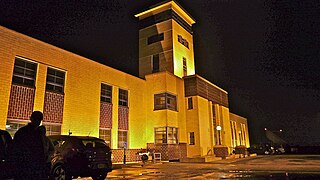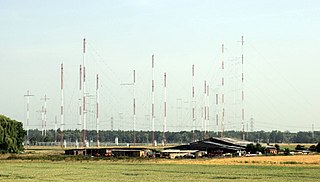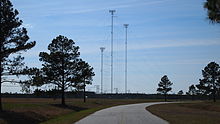
Shortwave radio is radio transmission using shortwave (SW) radio frequencies. There is no official definition of the band, but the range always includes all of the high frequency band (HF), which extends from 3 to 30 MHz ; above the medium frequency band (MF), to the bottom of the VHF band.

Voice of America is the state-owned news network and international radio broadcaster of the United States of America. It is the largest and oldest of the U.S.-funded international broadcasters. VOA produces digital, TV, and radio content in 48 languages, which it distributes to affiliate stations around the world. Its targeted and primary audience is non-American.
International broadcasting, in a limited extent, began during World War I, when German and British stations broadcast press communiqués using Morse code. With the severing of Germany's undersea cables, the wireless telegraph station in Nauen was the country's sole means of long-distance communication.

Greenville is the county seat of and the most populous city in Pitt County, North Carolina, United States; the principal city of the Greenville metropolitan area; and the 12th-most populous city in North Carolina. Greenville is the health, entertainment, and educational hub of North Carolina's Tidewater and Coastal Plain. As of the 2020 census, there were 87,521 people in the city. The Greenville, NC Metropolitan Statistical Area has also seen a population boom since the 1990s, as major companies have moved their regional and national headquarters to Greenville. Companies include Grady-White Boats, Hyster-Yale Group, Thermo Fisher Scientific, and Denso, among others. Minges Bottling Group, a large Pepsi facility is also located just outside Greenville.

Radio Televisión Martí is an American state-run radio and television international broadcaster based in Miami, Florida, financed by the federal government of the United States through the U.S. Agency for Global Media. It transmits news in Spanish to Cuba and its broadcasts can also be heard and viewed worldwide through their website and on shortwave radio frequencies.
JJY is the call sign of a low frequency time signal radio station located in Japan.

Radio Netherlands was a public radio and television network based in Hilversum, producing and transmitting programmes for international audiences outside the Netherlands from 1947 to 2012.

WITN-TV is a television station licensed to Washington, North Carolina, United States, serving Eastern North Carolina as an affiliate of NBC and MyNetworkTV. Owned by Gray Television, the station has primary studio facilities on East Arlington Boulevard in Greenville, with an additional studio in New Bern. Its transmitter is located in Grifton Township along NC 118.

Shortwave listening, or SWLing, is the hobby of listening to shortwave radio broadcasts located on frequencies between 1700 kHz and 30 MHz. Listeners range from casual users seeking international news and entertainment programming, to hobbyists immersed in the technical aspects of radio reception and collecting official confirmations that document their reception of distant broadcasts (DXing). In some developing countries, shortwave listening enables remote communities to obtain regional programming traditionally provided by local medium wave AM broadcasters. In 2002, the number of households that were capable of shortwave listening was estimated to be in the hundreds of millions.
Shortwave broadcasting in the United States allows private ownership of commercial and non-commercial shortwave stations that are not relays of existing AM/MW or FM radio stations, as are common in Africa, Europe, Asia, Oceania except Australia and Latin America. In addition to private broadcasters, the United States also has government broadcasters and relay stations for international public broadcasters. Most privately owned shortwave stations have been religious broadcasters, either wholly owned and programmed by Roman Catholic and evangelical Protestant charities or offering brokered programming consisting primarily of religious broadcasters. To better reach other continents of the world, several stations are located in far-flung US territories. Shortwave stations in the USA are not permitted to operate exclusively for a domestic audience; they are subject to antenna and power requirements to reach an international audience.

The Voice of America's Bethany Relay Station was located in Butler County, Ohio's Union Township about 25 miles (40 km) north of Cincinnati, adjacent to the transmitter site of WLW. Starting in 1944 during World War II it transmitted American radio programming abroad on shortwave frequencies, using 200,000-watt transmitters built by Crosley engineers under the direction of R.J. Rockwell. The site was developed to provide 'fallback' transmission facilities inland and away from the East Coast, where transmitters were located in Massachusetts, on Long Island in New York, and in New Jersey, all close to the ocean, subject to attack from German submarines or other invading forces.
Radio jamming is the deliberate jamming, blocking or interference with wireless communications. In some cases, jammers work by the transmission of radio signals that disrupt communications by decreasing the signal-to-noise ratio.
HCJB, "The Voice of the Andes", was the first radio station with daily programming in Ecuador and the first Christian missionary radio station in the world. The station was founded in 1931 by Clarence W. Jones, Reuben Larson, and D. Stuart Clark. HCJB now focuses on Ecuador with unified programming on FM at 89.3 MHz in Pichincha, at 92.5 MHz in Manabí, at 96.1 MHz in Tungurahua and Cotopaxi, at 98.3 MHz in Esmeraldas and with separate programming on AM at 690 kHz. Broadcasts in Spanish and indigenous languages on 6.05 MHz (1 kW), continue on an intermittent basis with a new solid state transmitter which in 2017 replaced an older (5 kW) transmitter. These broadcasts were not listed on the HCJB English website as of February 2016.

South Carolina Educational Television is a state network of PBS member television stations serving the U.S. state of South Carolina. It is operated by the South Carolina Educational Television Commission, an agency of the state government which holds the licenses for all of the PBS member stations licensed in the state. The broadcast signals of the eleven television stations cover almost all of the state, as well as parts of North Carolina and Georgia.

The Woofferton transmitting station is owned and operated by Encompass Digital Media, as one of the BBC's assets which were handed over as part of the privatization of World Service distribution and transmission in 1997. It is the last remaining UK shortwave broadcasting site, located at Woofferton, south of Ludlow, Shropshire, England. The large site spreads across into neighbouring Herefordshire.

Voice of Korea is the international broadcasting service of North Korea. It broadcasts primarily information in Chinese, Spanish, German, English, French, Russian, Japanese and Arabic. Until 2002 it was known as Radio Pyongyang. The interval signal is identical to that of Korean Central Television.
The International Broadcasting Bureau (IBB) is the technical support outlet within the United States Agency for Global Media (USAGM), which is a U.S. independent agency. The IBB supports the day-to-day operations of Voice of America (VOA) and the Office of Cuba Broadcasting. It also provides transmission and technical support for all of the independent non-military broadcasting services funded by the USAGM. The IBB is located in Washington, D.C.
A radiogram is a formal written message transmitted by radio. Also known as a radio telegram or radio telegraphic message, radiograms use a standardized message format, form and radiotelephone and/or radiotelegraph transmission procedures. These procedures typically provide a means of transmitting the content of the messages without including the names of the various headers and message sections, so as to minimize the time needed to transmit messages over limited and/or congested radio channels. Various formats have been used historically by maritime radio services, military organizations, and Amateur Radio organizations.
Radio jamming in China is a form of censorship in the People's Republic of China that involves deliberate attempts by state or Communist Party organs to interfere with radio broadcasts. In most instances, radio jamming targets foreign broadcasters, including Voice of America (VOA), Radio Free Asia, the BBC World Service, Sound of Hope (SOH) and stations based in Taiwan.

Curtain arrays are a class of large multielement directional radio transmitting wire antennas, used in the shortwave radio bands. They are a type of reflective array antenna, consisting of multiple wire dipole antennas, suspended in a vertical plane, often in front of a "curtain" reflector made of a flat vertical screen of many long parallel wires. These are suspended by support wires strung between pairs of tall steel towers, up to 90 m high. They are used for long-distance skywave transmission; they transmit a beam of radio waves at a shallow angle into the sky just above the horizon, which is reflected by the ionosphere back to Earth beyond the horizon. Curtain antennas are mostly used by international short wave radio stations to broadcast to large areas at transcontinental distances.














